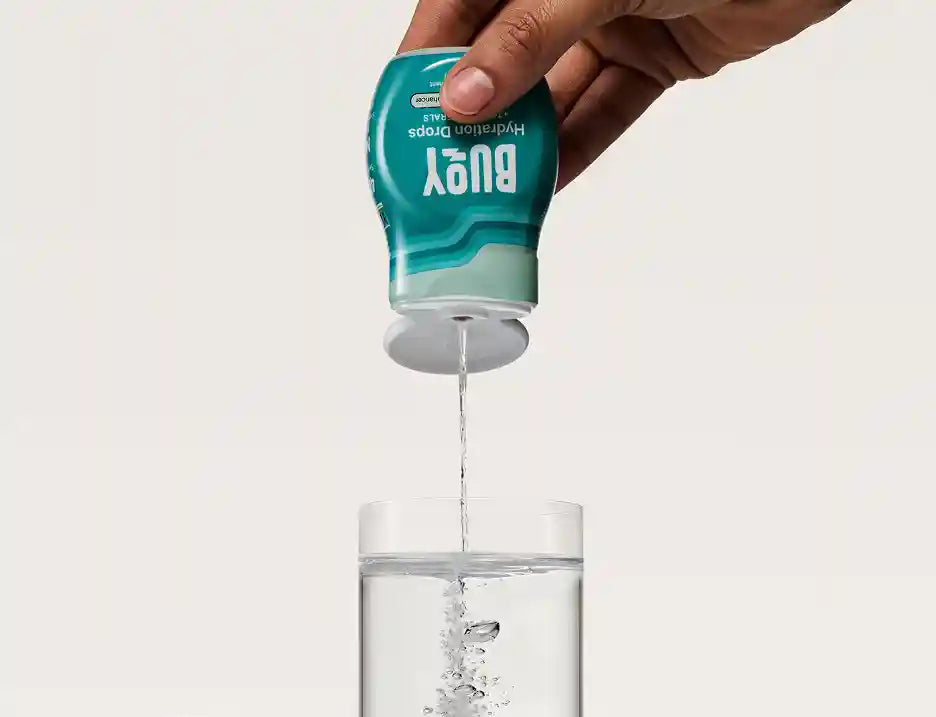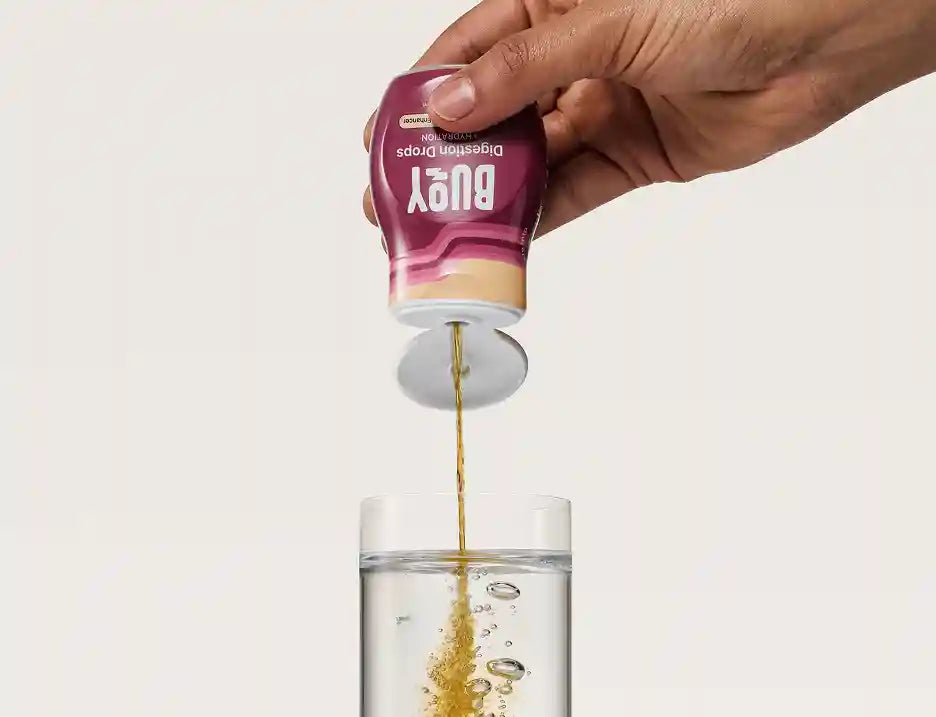
Electrolytes, Vitamins and Other Essential Nutrients
Significance of Electrolytes, Vitamins and Other Essential Nutrients
Vitamins and minerals are essential nutrients that the human body needs to function at its best. All vitamins and minerals are found in food sources, but which foods are adequate sources and how much each individual needs may vary.
We're going to cover everything you need to know about essential nutrients, electrolytes and vitamins, such as what they are, what they do and where you can find them.

Electrolytes, Vitamins and Other Essential Nutrients
- Vitamin A
- B Vitamins
- Vitamin C
- Vitamin D
- Vitamin E
- Vitamin K
- Iron
- Electrolytes
- Fuel Your Body With Buoy!
Vitamin A
Vitamin A is a fat-soluble vitamin that is found in many foods. It's important for healthy vision, immune function and reproductive health. It also supports vital organs like the lungs, heart and kidneys. Vitamin A comes in two forms: preformed vitamin A, which is found in animal products, and provitamin A, which is found in plant-based products.
Vitamin A needs vary by age, gender and physical condition, but the normal range for adult males is 900 micrograms (mcg) and adult females is 700 mcg. Most people get enough vitamin A from foods, but deficiencies occur in people in developing countries or with certain health conditions. Too much vitamin A can result in an orange skin tone, birth defects and toxicity, which may cause nausea, headaches, coma and death. Vitamin A food sources include:
- Beef liver and organ meats
- Fish
- Green, leafy vegetables
- Orange and yellow vegetables and fruits
- Dairy products
- Fortified cereals
B Vitamins
B vitamins include eight vitamins in total:
- B1 (thiamin)
- B2 (riboflavin)
- B3 (niacin)
- B5 (pantothenic acid)
- B6 (pyridoxine)
- B7 (biotin)
- B9 (folate)
- B12 (cobalamin)
Together, these vitamins are necessary for carbohydrate metabolism, fat metabolism, oxygen transport and other functions. Recommended intakes vary widely by the type of B vitamin, age, gender and medical conditions, though each B vitamin is found in many foods (whole grains, potatoes, bananas, beans, peppers, molasses and animal products to name a few).
Several of the B vitamins are notable for their roles in the body, as well as the problems with deficiencies:
Vitamin B6
Vitamin B6 (pyridoxine) is found naturally in many foods and supplemented in certain products. Some research suggests that B6 may reduce the risk of developing some types of cancer and heart disease.
Vitamin B9
Vitamin B9 (folate) is the natural form of B9 and occurs in many foods. It's also fortified in certain foods in the form of folic acid, which is more easily absorbed. Folate deficiencies are linked to birth defects.
Vitamin B12
Vitamin B12 (cobalamin) is naturally found in animal sources but may also be supplemented in the diet. It's necessary to the production of red blood cells and DNA, as well as optimal development and function of the brain. Like with B6, research suggests that B12 may reduce the risk of developing some types of cancer and heart disease.
Vitamin C
L-ascorbic acid, or vitamin C, is a water-soluble vitamin that's found in many foods, fortified in others and available as a dietary supplement. While most animals can manufacture vitamin C on their own, humans must get vitamin C from their diet.
Vitamin C is necessary for many bodily functions, including the production of collagen, protein metabolism, connective tissue health, wound healing, neurotransmitter function and more. Vitamin C recommendations vary by age, gender, lifestyle habits and certain health conditions, but it's recommended for adult females to get 75 mg per day (85-120 mg for pregnant women) and for adult males to get 90 mg per day.
Vitamin C food sources include:
- Citrus fruits (particularly oranges)
- Tomatoes
- Potatoes
- Red and green peppers
- Berries
- Brussels sprouts
- Cantaloupe
- Fortified cereals
Vitamin C deficiency leads to scurvy, a common condition among 18th-century sailors. Its symptoms include fatigue, malaise, gum inflammation, joint pain, poor wound healing, hyperkeratosis, loss of teeth and iron-deficiency anemia.
Vitamin D
Vitamin D is a fat-soluble vitamin that is found in a small number of foods, as a dietary supplement and from exposure to sunlight. Vitamin D is essential to calcium absorption in the gut, as well as normal bone mineralization. It also plays a role in cellular growth modulation, immune function and neuromuscular function.
Vitamin D requirements vary by age and gender, but adult males and females should get between 600 IU and 800 IU. A vitamin D deficiency can be caused by a lack of dietary nutrients, excess excretion and impaired absorption, which may cause conditions like rickets, osteomalacia, skeletal deformities and brittle bones.
Vitamin D sources include:
- Fatty fish
- Beef liver
- Fortified dairy products
- Fortified juices
- Fortified cereals
- Sunlight
- Dietary supplements
Vitamin E
Vitamin E is a fat-soluble vitamin group that exists in several chemical forms. It occurs naturally in some foods, but many are fortified with vitamin E. One of the key benefits of vitamin E is its antioxidant properties, which stop free-radical damage that occurs when fat undergoes oxidation. It's also important for immune function, cell signaling and enzyme activity. Vitamin E requirements vary, but both males and females over the age of 14 should get 15 mg.
Vitamin E sources include:
- Nuts and seeds
- Vegetable oils
- Green, leafy vegetables
- Dietary supplements
Vitamin E deficiency is rare, but individuals on a low-fat diet may develop deficiencies from poor absorption.
Vitamin K
Vitamin K is the name of a group of fat-soluble compounds that occur naturally in foods. Vitamin K is a coenzyme for carboxylase, an enzyme necessary to protein synthesis, blood clotting and bone metabolism. Vitamin K needs vary, but it's recommended that adult males get between 75 mcg and 120 mcg, while adult females should get between 75 mcg and 90 mcg.
Vitamin K sources include:
- Green, leafy vegetables
- Vegetable oils
- Fruits
- Dietary supplements
Iron
Iron is a mineral that occurs naturally in many foods, is added to others and may be supplemented. It's an essential component of hemoglobin, a protein in red blood cells that transfers oxygen from the lungs to tissues. Iron supports muscle metabolism, connective tissue, growth, neurological development and hormone synthesis.
Dietary iron comes in two forms: heme and non-heme iron. Animal products such as meat, seafood and poultry contain heme iron. Plant-based products and fortified foods contain non-heme iron. Heme iron is more bioavailable, meaning that it's better absorbed by the body. Iron needs vary by age, gender and health conditions, but adult males should get between 11 mg and 18 mg, while adult females should get between 15 mg and 18 mg (27 mg for pregnant women).
Iron sources include:
- Lean meat and seafood
- Nuts
- Beans
- Vegetables
- Fortified grains
- Dietary supplements
Most people obtain enough iron from their diet, but infants, young children, teenage girls, pregnant women and premenopausal women are more likely to have a deficiency. Certain health conditions may contribute to deficiencies, such as hereditary hemochromatosis. Symptoms of an iron deficiency include anemia, poor body temperature regulation, impaired cognitive function, impaired immune function, weakness, fatigue and gastrointestinal disturbances.
Electrolytes
Electrolytes are chemicals that form electrically charged particles known as ions. This electrical energy is necessary for nerve impulses, smooth and skeletal muscle contractions, water equilibrium and many other functions.
The types of electrolytes in the body include:
- Sodium
- Potassium
- Chloride
- Calcium
- Magnesium
- Calcium
- Phosphate
- Bicarbonate
Certain electrolytes work together, such as sodium and potassium. When electrolyte levels become imbalanced or are too high or low, it can be harmful to your health. Electrolyte loss or imbalances usually occur as a result of dehydration from excessive sweating, vomiting and diarrhea. Individuals who exercise in hot environments, endurance athletes and people recovering from illness are at a greater risk of electrolyte imbalance.
When this occurs, electrolytes need to be replaced along with fluids to restore electrolyte balance. Severe electrolyte imbalances can cause symptoms like fatigue, numbness, confusion, muscle weakness, cramping, headaches and irregular heartbeat.
Electrolyte sources include:
- Sodium: Pickled foods, table salt, cheese, processed foods
- Potassium: Fruits and vegetables
- Chloride: Table salt
- Magnesium: Seeds and nuts, grains
- Calcium: Fortified dairy products and cereals; green, leafy vegetables
Bicarbonate is naturally produced in the body, so it doesn't need to come from dietary sources. Other electrolytes can be supplemented with electrolyte powders or electrolyte drinks.
Fuel Your Body With Buoy!
Whether you're undergoing a tough training regimen or you're looking to improve your diet to ensure that you get the vitamins and minerals you need, Buoy is an excellent addition. Buoy electrolytes are squeezable, environmentally-conscious, and can easily be added to your morning coffee, workout water bottle or any other drink you wish for a quick and easy boost of sodium, potassium, magnesium and more! Squeeze your Buoy to get the fuel your body needs!

Keywords:
Electrolytes and vitamins, Electrolyte supplement, Electrolyte powder, Electrolytes, Types of electrolytes, Vitamins, Nutrients
References:
- Office of Dietary Supplements - Vitamin A. (n.d.). Retrieved June 27, 2020, from https://ods.od.nih.gov/factsheets/VitaminA-Consumer/
- Office of Dietary Supplements - Vitamin C. (n.d.). Retrieved June 27, 2020, from https://ods.od.nih.gov/factsheets/VitaminC-HealthProfessional/
- Office of Dietary Supplements - Vitamin D. (n.d.). Retrieved June 27, 2020, from https://ods.od.nih.gov/factsheets/VitaminD-HealthProfessional/
- Office of Dietary Supplements - Vitamin E. (n.d.). Retrieved June 27, 2020, from https://ods.od.nih.gov/factsheets/VitaminE-HealthProfessional/
- Office of Dietary Supplements - Vitamin K. (n.d.). Retrieved June 27, 2020, from https://ods.od.nih.gov/factsheets/vitaminK-HealthProfessional/
- Office of Dietary Supplements - Iron. (n.d.). Retrieved June 27, 2020, from https://ods.od.nih.gov/factsheets/Iron-HealthProfessional/
- JE;, R. (n.d.). Neurologic Manifestations of Electrolyte Disturbances. Retrieved June 27, 2020, from https://pubmed.ncbi.nlm.nih.gov/11754308/




